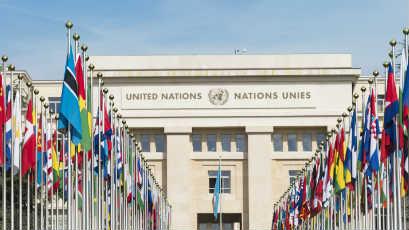Asset Publisher

Geneva: the unknown birthplace of European unification
2016
Edo KORLJAN

While taking a stroll in the city centre, in rue de Rhone, a sign on the building situated at number 65 caught my attention. It indicated that the famous Salle de la Réformation, the seat of the League of Nations, used to be there. The memories from my student days overwhelmed me. Was that the building with so much historical significance for Europe and the world? And yes, it was.
On 5 September 1929, the Salle de la Réformation witnessed a historical event, when the then French Prime Minister Aristide Briand proposed a concrete vision of Europe, to evolve from multiple sovereign states to an entity known as the European Federal Union, a Europe without borders and customs. He obtained unanimous support for the proposal from all of the 26 European states1. Although his “Memorandum on the Organization of a System of the European Federal Union” came under severe scrutiny, none of the European delegations dismissed the plan for such an entity. Several scholars argued that some states only agreed to support the concept out of courtesy, social cynicism or peer pressure. However, the consent was still unanimous. Particularly important was the support of the then German Foreign Minister Gustav Stresemann, a strong defender of German interests, but also an ardent anti-Nazi politician, whose statue still has its rightful place at the German Permanent mission in Geneva.
In retrospect, a number of analysts assess that the project was created to protect mainly French national interests. Indeed, France was weakened, its economy was exhausted and its political elite had no illusions about Germany’s powerful rise. The Weimar Republic was already reasserting its influence with the Treaty of Locarno, essentially accepting the status quo of its borders with France and Belgium. Yet, its Eastern neighbours were not extended similar assurances. Some think that if France had truly acted in moral interest, it would have pressed Germany to extend equal guarantees to its Eastern neighbours. However, this fact alone does not diminish the greatness of the dream of united Europe.
As today, building a united Europe for many meant losing national identities. Acknowledging their fears, Briand displayed a profound understanding of the socio-economic and cultural setting. He recognized that economic factors are insufficient to ensure a true and lasting unity. In his view, the breaking down of physical barriers also meant breaking down of moral barriers, centuries-old disputes, cultural and historic differences in favour of lasting peace, economic growth, prosperity, and democracy. To sum up, Europe would only endure if based on shared moral values and solidarity.
This thinking comes after the cataclysm of World War I, when a strong pan-European intellectual movement emerged and articulated the vision of a common European dream. As de Wagt recently described, “most propagandists of united Europe felt they were part of a broad, European consciousness, a sort of spiritual paradise lost, that they wanted to regain”. The Romanian scholar, writer and philosopher Constantin Radulescu-Motru thought that there was hardly a better time for a unified Europe, precisely because of the enormous suffering inflicted by the World War I – as “the seeds of solidarity are now planted in a fertile soil - that of a common suffering”.
Therefore, one of the major Briand’s ideas was that a meaningful, genuine European integration could be achieved not only through economic and trade activity, but also by fostering a sense of shared identity. Integration efforts would seek to shape a collective European memory, and bring people around shared moral values, inclusivity and equality. With the advantage of hindsight, this appears like the reasoning behind two major European organizations, the Council of Europe and the European Union.
Unfortunately, the dream never came true. Geneva is a birthplace of many other great ideas, concepts, visions, and organizations. The city is home to Calvin, Jean-Jacques Rousseau and Voltaire, whose powerful legacies continue to influence. It is also home to Henry Dunant, who created the Red Cross there in the hope that even wars could be more humane. Further, it is the home to Jean-Jacques Gautier, whose work inspired the creation of our Committee on Prevention of Torture, claiming that torture could be prevented with visits to persons detained. Further, Geneva is also home to the European Centre for Nuclear Research (CERN), International Labour Organization (ILO), United Nations High Commissioner for Refugees (UNHCR), Office of the High Commissioner for Human Rights (OHCHR) and the World Health Organization (WHO), among others, and it is one of three non-capitals which house international organizations (besides New York and Strasbourg). Why then the vision of European Federal Union did not evolve in a city of such an international vocation?
Much like the League of Nations, this project was bound to fail – because of its unfortunate timing. Briand and Stresemann died two years after Briand’s memorandum, and did not see their aspirations realized. The failure of the League, the rise of ultra-nationalism and appeasement policies during the Weimar and the Third Reich period, proved to be too much of a destructive force. As Joshua Harris put it - “the right thing at the wrong time is the wrong thing”.
Why is this story important now? Are there today any similarities with Europe between the two wars? Why is this the Council of Europe story par excellence?
Briand’s Memorandum analysis appears to be so applicable to present Europe. Like in the 1920s, Europe faces dramatic issues. The economic disparities between and within the states should not be underestimated. Our population is ageing. Nationalism and populism are on the rise. In this context, European countries have drastically divergent refugee and migration policies, which is clearly not only an economic issue, and should prompt us to revisit our understanding of the word “solidarity”, used by courageous European leaders almost ninety years ago.
Nonetheless, the examination of Briand’s beliefs and knowledge of this well-hidden story might represent an added value, as our continent is facing issues of common European identity. Europe should not make the mistake of taking unity, prosperity and peace for granted. The renewed calls for the re-establishment of the death penalty in certain European states are a striking example in this regard.
Historically speaking, the concept of United Europe has evolved from first addressing its geographical borders, to eventually adding the variables of common cultural identity and economic-political integration. And this is where the role of the Council of Europe should be underlined.
Having served in Geneva convinced me of the particular relevance of European standards, especially for non-European states, as they are usually higher than those of the UN (if they exist at all at UN level, like in data protection area). Latest ratifications of several of Council of Europe legal instruments are a good example of it. There is also a lot of interest for our success stories, such as for the Venice Commission or GRECO, which are open to non-member states. Further, our visibility is increased by hundreds of NGOs and journalists present in Geneva. When the CoE Secretary General or other senior officials address the Human Rights Council, Internet Governance Forum, European Broadcasting Union, or other institutions or events, they are listened to by the UN member states, other international, but also non-governmental organizations.
Our organization is a leading regional organization for the protection of human rights. Continents like Africa and America have their regional human rights protection systems as well (not Asia, partially organized in ASEAN), but it is widely recognized that our system is the most developed one. Therefore, Geneva is the place where universal meets the regional, and where the regional excels, thus reinforcing my belief in the necessity of strengthening Council of Europe’s presence there.
I would like to believe that our organization is a proud successor of Briand’s ideas. Geneva’s catalytic role in European unification is a powerful reminder that wwithout shared moral values or adherence to a common cause and identity, Europe could never genuinely ensure sustainable peace, prosperity and unity.
Geneva became known for its internationally-minded, universalist path, aiming to cover the whole world. However, one of the first pages of European unification was indeed written there. This Geneva-inspired European story should serve as a reminder of the importance of shared values and solidarity, but also the platform for future Council of Europe endeavours to raise its visibility.
1 The European states of the League of Nations in 1929 were Belgium, Czechoslovakia, Denmark, France, Greece, The Netherlands, Italy, Norway, Poland, Portugal, Romania, Spain, Sweden, Switzerland, Yugoslavia, Austria, Bulgaria, Finland, Luxembourg, Albania, Estonia, Latvia, Lithuania, Hungary, Ireland and Germany. The coverage of the continent was very wide, with the most notable exception of the USSR, who joined in 1934, and Turkey (in 1932).



